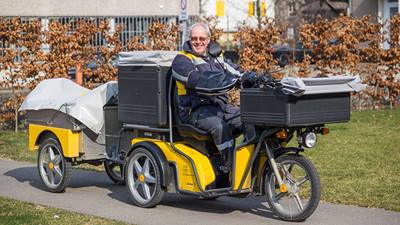Swiss Post's second lease of life
One year ago: Martin Wettstein was sorting the used clothes of Swiss Post employees in the Swiss Red Cross logistics center. The popular all-rounder was also responsible for warehouse management and certain areas of logistics. He was preparing himself for the primary labour market – and ensured that the high-quality textiles could be re-used.
Rich Content Section



Grey fleece jackets, sturdy work trousers with handy pockets, light yellow blouses and much more: Martin Wettstein picked up every piece of clothing and checked: Were the buttons still on? The seams intact? Was the item worn out? Every day, he examined kilos of textiles at the Swiss Red Cross (SRC) La Trouvaille logistics center in Berne. He sorted the clothes according to their condition and category.
Quality for a little money – or for free
The SRC sells anything that is as good as new at cheap prices in its La Trouvaille second-hand warehouses. Clothes in good condition but with small defects are donated to organizations such as Swiss Mountain Aid via Tell-Tex. Mountain farming families receive them free of charge. Clothes that are no longer fit to be worn, even typical Swiss Post accessories such as foulards or ties are thermally recycled: ideally, the heat from the incineration process is used to produce electricity or energy. Every year, the SRC processes an average of 15 tonnes of Swiss Post work clothes – and Martin Wettstein keeps exact statistics about the incoming goods.
Brand protection and circular economy: no contradiction
A major challenge in the recycling process is brand protection: whatever is sold or donated cannot carry any Swiss Post label. “Otherwise, anyone could masquerade as a mail carrier,” explains Martin Wettstein. “On many items, we therefore have to carefully remove the label.” As part of integration measures, this is done by people with a health-related or social impairment. Wettstein, the all-rounder, is also responsible for quality control.
“Nowadays, there is also an initial solution for the raincoats with the large Swiss Post logo printed on the back,” he explains – once again in the know as they also pass through his hands. “In the protected BEWO workshops in Oberburg, little bags are now created using the logo as a deliberate eye-catcher.” Antonia Stalder, the Swiss Post Corporate Responsibility Project Manager also believes that this pilot project is a great example of the circular economy: “We close the circle by producing these bags – from fair production of our work clothes through the donation to the Red Cross to the upcycling of the discarded raincoats to make bags.” Other ideas are in the pipeline.
Jobs for jobseekers
Martin Wettstein has now been working for a good two years in the Swiss Red Cross logistics center. During his time there, he has had the opportunity to gain further qualifications while ensuring safety and stability for himself. He has seized this opportunity with both hands – and has found a job on the primary labour market. This is an encouraging success story for the cooperation between Swiss Post and the SRC.




